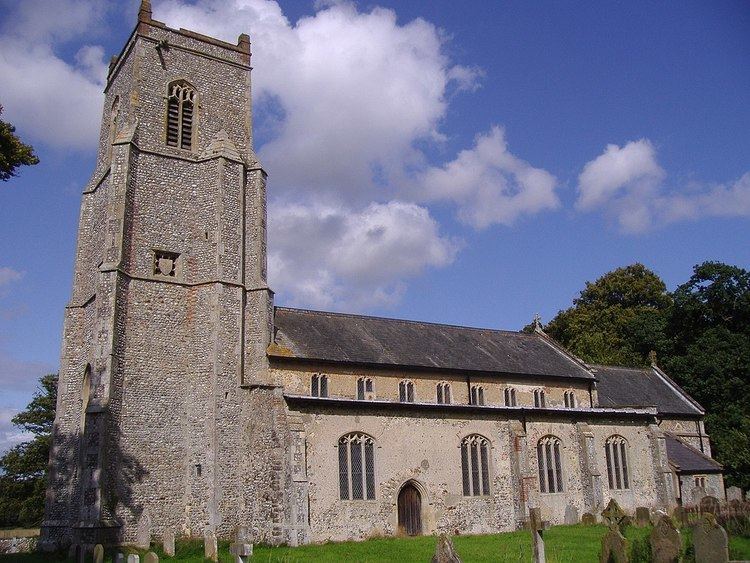Population 169 (2011 census) Civil parish Hanworth CP Area 8.74 km² Dialling code 01263 | OS grid reference TG190350 Sovereign state United Kingdom Local time Thursday 5:03 AM | |
 | ||
Weather 7°C, Wind SW at 19 km/h, 88% Humidity | ||
Hanworth is a village and a civil parish in the English county of Norfolk. The village is 18.8 miles (30.3 km) north of Norwich, 5.4 miles (8.7 km) south-west of Cromer and 133 miles (214 km) north-east of London. The nearest railway station is in the village of Gunton where access to the national rail network can be made via the Bittern Line to Norwich. The nearest airport is Norwich International Airport.The parish had in 2001 census and 2011 census, a population of 169. For the purposes of local government, the parish falls within the district of North Norfolk.
Contents
- Map of Hanworth UK
- History
- Tudor period
- The parish church of Saint Bartholomew
- A brief history of Hanworth Common
- References
Map of Hanworth, UK
History
Hanworth has an entry in the Domesday Book of 1085. In the great book, Hanworth is recorded by the name Hagan(a)worda; the main landholder being Roger Bigot . The survey also mentions that there were two mills, 8 beehives,5 cobs and 24 cattle.
Tudor period
In the Tudor period, during the reign of Henry VIII and probably before, the principal landowner of the parish was the Doughty Family. The family home, Hanworth Hall, was the Doughty's residence from the 15th to the 18th century. The hall was rebuilt after a fire in 1686. Within the grounds of the hall there is a notable Spanish chestnut tree which is thought to be over 300 years old.
The parish church of Saint Bartholomew
The parish church of Saint Bartholomew dates from the 14th century but parts of the building date from an earlier building. On the outside north wall of the chancel , there are traces of Saxon windows. On the eastern elevation, the east window dates from between 1290 and 1350. The Nave and South aisles are of a later date. The windows are perpendicular in style and date from between 1350 and 1530, and small pieces of medieval stained glass can be seen in the top lights. The Clerestory has an unusual arrangement of two windows to each arch. The tower is constructed from flint and has traceried sound holes and was built in the 15th century. The tower houses five bells. The font dates from before the present church and has a large bowl supported by four plain pillars. Hanging over the chancel arch there are the royal arms of Queen Anne (1702–1714) which were adopted by the crown after the union of England and Scotland in 1707. The church organ was built around 1865 by Father Henry Willis the famous London organ builder. It originally cost £70 and is the only miniature Father Willis organ in Norfolk. .
A brief history of Hanworth Common
Hanworth Common lies between Cromer and Aylsham in North Norfolk. The name is derived from Hagana (the Dane who invaded Norfolk in 870 AD, and whose name was anglicised to Han), and 'worth' meaning waters, which relates to the two streams that enclose the parish - Hagon Beck and Scarrow Beck. The Weavers' Way from Cromer to Great Yarmouth runs through the village.
The Common covers 35 acres (14 ha) protected by cattle grids, and is the largest such enclosed common in England.
The first maps of Hanworth Common go back to 1628, when the Doughty family bought the Manor of Hanworth from the Duke of Norfolk. They bought more land from the Earl of Surrey in 1690. At the time, there were three commons - Bell House Common, Hook Hill Common and Barn Stable Common - together constituting Hanworth Green.
In 1845, Hanworth Park, which did not include The Common, was bought by the Windham family of Felbrigg Hall.
In the 1860s, Hanworth was a thriving community of about 230 people, and several artists (including Humphry Repton and John Sell Cotman) came to paint it. There were many businesses — a dressmaker, stonemason, blacksmith, and wood-carver. The blacksmith's was destroyed by a German bomb in 1940.
Hanworth Common has been managed by a committee since at least 1909, the earliest minutes that are held, and all residents have grazing rights. In 1972, Hanworth Common was registered under the Commons Registration Act 1965, and, as there was no known owner, Possessory Title was granted to the Hanworth Commons Management Committee in 1974. The committee is responsible for managing The Common and letting the grazing. About 50 cattle now graze the Common from May to October.
In late 2004, Robert Harbord Hammond, youngest son of the 11th Baron of Suffield, claimed ownership of Hanworth Common and attempted to charge residents of Hanworth to use the land. In October 2006 a court rejected his claim and ruled that the land belonged to the people of the village by virtue of adverse possession.
